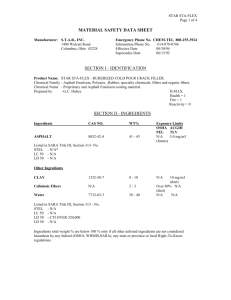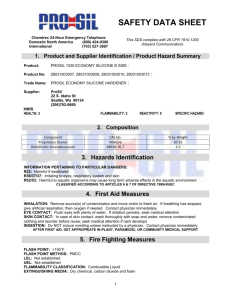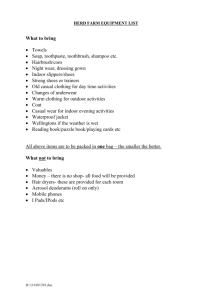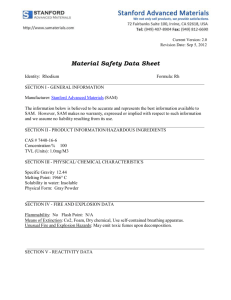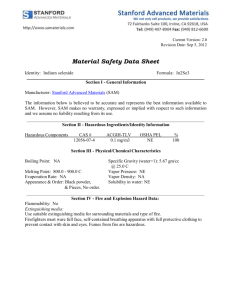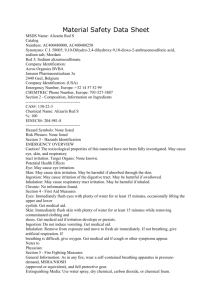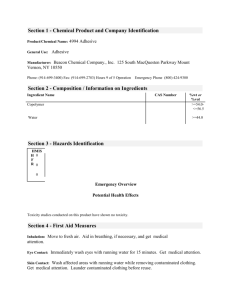chemicals_safety_read_carefully
advertisement
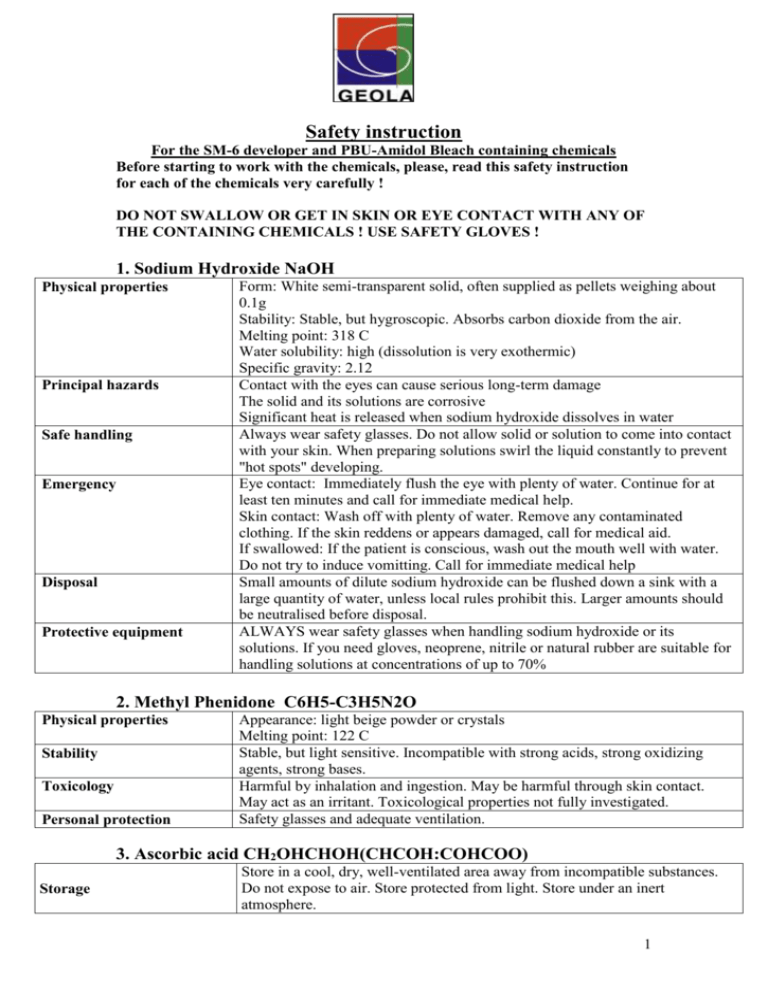
Safety instruction For the SM-6 developer and PBU-Amidol Bleach containing chemicals Before starting to work with the chemicals, please, read this safety instruction for each of the chemicals very carefully ! DO NOT SWALLOW OR GET IN SKIN OR EYE CONTACT WITH ANY OF THE CONTAINING CHEMICALS ! USE SAFETY GLOVES ! 1. Sodium Hydroxide NaOH Physical properties Principal hazards Safe handling Emergency Disposal Protective equipment Form: White semi-transparent solid, often supplied as pellets weighing about 0.1g Stability: Stable, but hygroscopic. Absorbs carbon dioxide from the air. Melting point: 318 C Water solubility: high (dissolution is very exothermic) Specific gravity: 2.12 Contact with the eyes can cause serious long-term damage The solid and its solutions are corrosive Significant heat is released when sodium hydroxide dissolves in water Always wear safety glasses. Do not allow solid or solution to come into contact with your skin. When preparing solutions swirl the liquid constantly to prevent "hot spots" developing. Eye contact: Immediately flush the eye with plenty of water. Continue for at least ten minutes and call for immediate medical help. Skin contact: Wash off with plenty of water. Remove any contaminated clothing. If the skin reddens or appears damaged, call for medical aid. If swallowed: If the patient is conscious, wash out the mouth well with water. Do not try to induce vomitting. Call for immediate medical help Small amounts of dilute sodium hydroxide can be flushed down a sink with a large quantity of water, unless local rules prohibit this. Larger amounts should be neutralised before disposal. ALWAYS wear safety glasses when handling sodium hydroxide or its solutions. If you need gloves, neoprene, nitrile or natural rubber are suitable for handling solutions at concentrations of up to 70% 2. Methyl Phenidone C6H5-C3H5N2O Physical properties Stability Toxicology Personal protection Appearance: light beige powder or crystals Melting point: 122 C Stable, but light sensitive. Incompatible with strong acids, strong oxidizing agents, strong bases. Harmful by inhalation and ingestion. May be harmful through skin contact. May act as an irritant. Toxicological properties not fully investigated. Safety glasses and adequate ventilation. 3. Ascorbic acid CH2OHCHOH(CHCOH:COHCOO) Storage Store in a cool, dry, well-ventilated area away from incompatible substances. Do not expose to air. Store protected from light. Store under an inert atmosphere. 1 Handling Protection Respirators Small spills/leaks Stability Incompatibilities Decomposition Other hazards Wash thoroughly after handling. Remove contaminated clothing and wash before reuse. Minimize dust generation and accumulation. Avoid contact with eyes, skin, and clothing. Keep container tightly closed. Avoid ingestion and inhalation. Use with adequate ventilation. Store protected from light. Handle under an inert atmosphere. Store protected from air. Eyes: Wear appropriate protective eyeglasses or chemical safety goggles as described by OSHA's eye and face protection regulations in 29 CFR 1910.133 or European Standard EN166. Skin: Wear appropriate protective gloves to prevent skin exposure. Clothing: Wear appropriate protective clothing to minimize contact with skin. A respiratory protection program that meets OSHA's 29 CFR 1910.134 and ANSI Z88.2 requirements or European Standard EN 149 must be followed whenever workplace conditions warrant a respirator's use. Clean up spills immediately, using the appropriate protective equipment. Avoid generating dusty conditions. Carefully scoop up and place into appropriate disposal container. Provide ventilation. Place under an inert atmosphere. Stable at room temperature in closed containers under normal storage and handling conditions. Oxidizing agents. Carbon monoxide, irritating and toxic fumes and gases, carbon dioxide. In concentrations greater than 100 mg/ml, ascorbic acid may undergo decomposition with the production of carbon dioxide. Since increased pressure may develop after prolonged storage, ampuls containing ascorbic acid injections should be opened carefully. 4. Sodium Phosphate (dibasic) Na2HPO4 Physical properties Stability Toxicology Personal protection Appearance: white granular powder; Vapour density: 4.9; Specific gravity: 1.679 Stable. Incompatible with strong acids. Hygroscopic. Eye and skin irritant. May be harmful if ingested in quantity. Handle with care. 5. Potassium persulfate K2S2O8 Storage Handling Protection Respirators Small spills/leaks Keep away from heat, sparks, and flame. Do not store near combustible materials. Store in a cool, dry place. Keep containers tightly closed. Wash thoroughly after handling. Remove contaminated clothing and wash before reuse. Use with adequate ventilation. Minimize dust generation and accumulation. Avoid contact with clothing and other combustible materials. Do not get on skin or in eyes. Avoid ingestion and inhalation. Eyes: Wear appropriate protective eyeglasses or chemical safety goggles as described by OSHA's eye and face protection regulations in 29 CFR 1910.133 or European Standard EN166. Skin: Wear appropriate gloves to prevent skin exposure. Clothing: Wear a chemical apron. Wear appropriate clothing to prevent skin exposure. Wear a NIOSH/MSHA or European Standard EN 149 approved full-facepiece airline respirator in the positive pressure mode with emergency escape provisions. Avoid runoff into storm sewers and ditches which lead to waterways. Clean up spills immediately, using the appropriate protective equipment. Sweep up, then place into a suitable container for disposal. Avoid generating dusty conditions. Remove all sources of ignition. Provide ventilation. 2 Stability Stable under normal temperatures and pressures. Incompatibilities Reducing agents. Decomposition Oxygen, oxides of potassium, sulfur oxides (SOx), including sulfur oxide and sulfur dioxide. 6. Citric acid HOC(COOH)(CH2COOH)2 Decomposition Store in a tightly closed container. Store in a cool, dry, well-ventilated area away from incompatible substances. Store protected from moisture. E - Corrosive material Wash thoroughly after handling. Use with adequate ventilation. Minimize dust generation and accumulation. Avoid contact with eyes, skin, and clothing. Keep container tightly closed. Avoid ingestion and inhalation. Do not allow contact with water. Keep from contact with moist air and steam. Eyes: Wear appropriate protective eyeglasses or chemical safety goggles as described by OSHA's eye and face protection regulations in 29 CFR 1910.133 or European Standard EN166. Skin: Wear appropriate protective gloves to prevent skin exposure. Clothing: Wear appropriate protective clothing to prevent skin exposure. Follow the OSHA respirator regulations found in 29CFR 1910.134 or European Standard EN 149. Always use a NIOSH or European Standard EN 149 approved respirator when necessary. Vacuum or sweep up material and place into a suitable disposal container. Very fine particles can cause a fire or explosion. Eliminate all ignition sources. Clean up spills immediately, using the appropriate protective equipment. Avoid generating dusty conditions. Remove all sources of ignition. Provide ventilation. Spill may be neutralized with lime. Do not get water inside containers. Stable under normal temperatures and pressures. Oxidizing agents, sulfides (inorganic, e.g. ferric sulfide, lead sulfide, sodium sulfide), metal nitrates, alkali carbonates, alkalis, potassium tartrate, acetates, bicarbonates. Carbon monoxide, irritating and toxic fumes and gases, carbon dioxide. Other hazards Will attack some metals like brass or copper forming citrate complexes. Storage WHMIS Handling Protection Respirators Small spills/leaks Stability Incompatibilities 7. Cupric bromide CuBr2 Storage Handling Protection Respirators Small spills/leaks Store in a cool, dry place. Store in a tightly closed container. Wash thoroughly after handling. Wash hands before eating. Use only in a well ventilated area. Avoid breathing dust, vapor, mist, or gas. Avoid contact with skin and eyes. Avoid ingestion and inhalation. Eyes: Wear appropriate protective eyeglasses or chemical safety goggles as described by OSHA's eye and face protection regulations in 29 CFR 1910.133 or European Standard EN166. Skin: Wear appropriate protective gloves to prevent skin exposure. Clothing: Wear appropriate protective clothing to prevent skin exposure. Follow the OSHA respirator regulations found in 29CFR 1910.134 or European Standard EN 149. Always use a NIOSH or European Standard EN 149 approved respirator when necessary. Vacuum or sweep up material and place into a suitable disposal container. Clean up spills immediately, using the appropriate protective equipment. Avoid 3 generating dusty conditions. Provide ventilation. Stability Stable under normal temperatures and pressures. Incompatibilities Moisture, potassium, and alkali metals. Decomposition Irritating and toxic fumes and gases, hydrogen bromide, copper fumes. Other hazards Moisture sensitive. 8. Potassium bromide KBr Storage Handling Protection Respirators Small spills/leaks Stability Incompatibilities Decomposition Store in a cool, dry place. Store protected from moisture. Wash thoroughly after handling. Remove contaminated clothing and wash before reuse. Use with adequate ventilation. Avoid contact with eyes. Do not ingest or inhale. Eyes: Wear appropriate protective eyeglasses or chemical safety goggles as described by OSHA's eye and face protection regulations in 29 CFR 1910.133 or European Standard EN166. Skin: Wear appropriate gloves to prevent skin exposure. Clothing: Wear appropriate protective clothing to minimize contact with skin. Follow the OSHA respirator regulations found in 29CFR 1910.134 or European Standard EN 149. Always use a NIOSH or European Standard EN 149 approved respirator when necessary. Sweep up, then place into a suitable container for disposal. Avoid generating dusty conditions. Provide ventilation. Do not expose spill to water. Stable under normal temperatures and pressures. Strong oxidizing agents; strong acids; heavy metal salts Reacts violently with bromine trifluoride. Hydrogen bromide, oxides of potassium. 9. Amidol (NH2)2C6H3OH2HCl Stability Store in a tightly closed container. Store in a cool, dry, well-ventilated area away from incompatible substances. Wash thoroughly after handling. Use with adequate ventilation. Minimize dust generation and accumulation. Avoid contact with eyes, skin, and clothing. Keep container tightly closed. Do not ingest or inhale. Eyes: Wear appropriate protective eyeglasses or chemical safety goggles as described by OSHA's eye and face protection regulations in 29 CFR 1910.133 or European Standard EN166. Skin: Wear appropriate protective gloves to prevent skin exposure. Clothing: Wear appropriate protective clothing to prevent skin exposure. Follow the OSHA respirator regulations found in 29CFR 1910.134 or European Standard EN 149. Always use a NIOSH or European Standard EN 149 approved respirator when necessary. Sweep up or absorb material, then place into a suitable clean, dry, closed container for disposal. Avoid generating dusty conditions. Stable under normal shipping and handling conditions. Incompatibilities Strong oxidizing agents. Storage Handling Protection Respirators Small spills/leaks Hydrogen chloride, nitrogen oxides, carbon monoxide, carbon dioxide. Decomposition Afterall, If you have any questions, comments or obscurities, please visit our website at http://www.geola.lt or contact us by e-mail info@geola.com. 4

